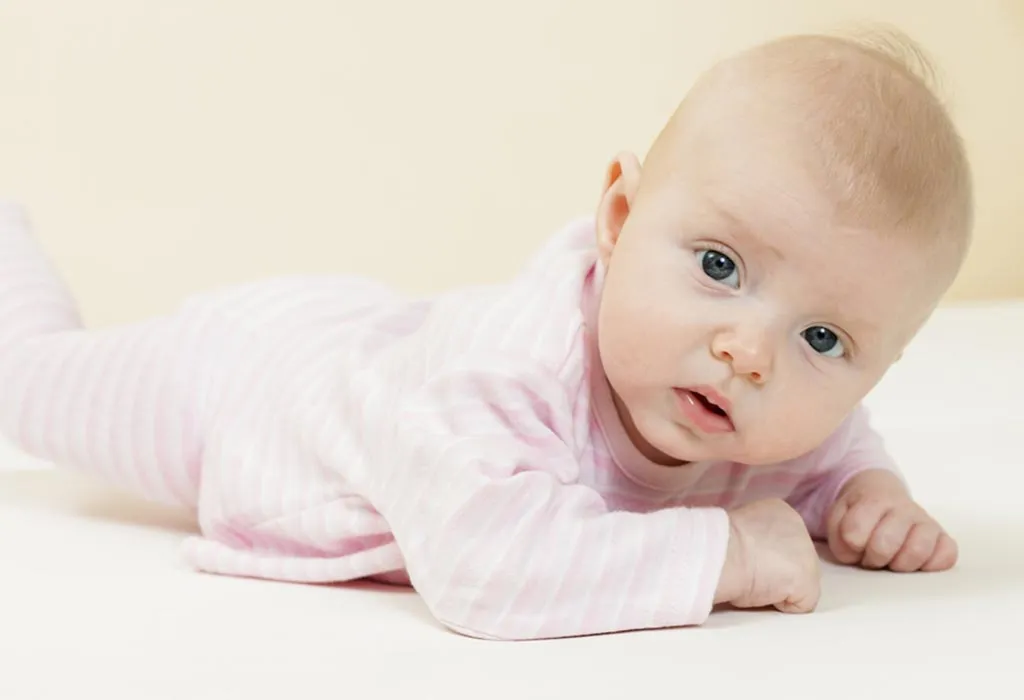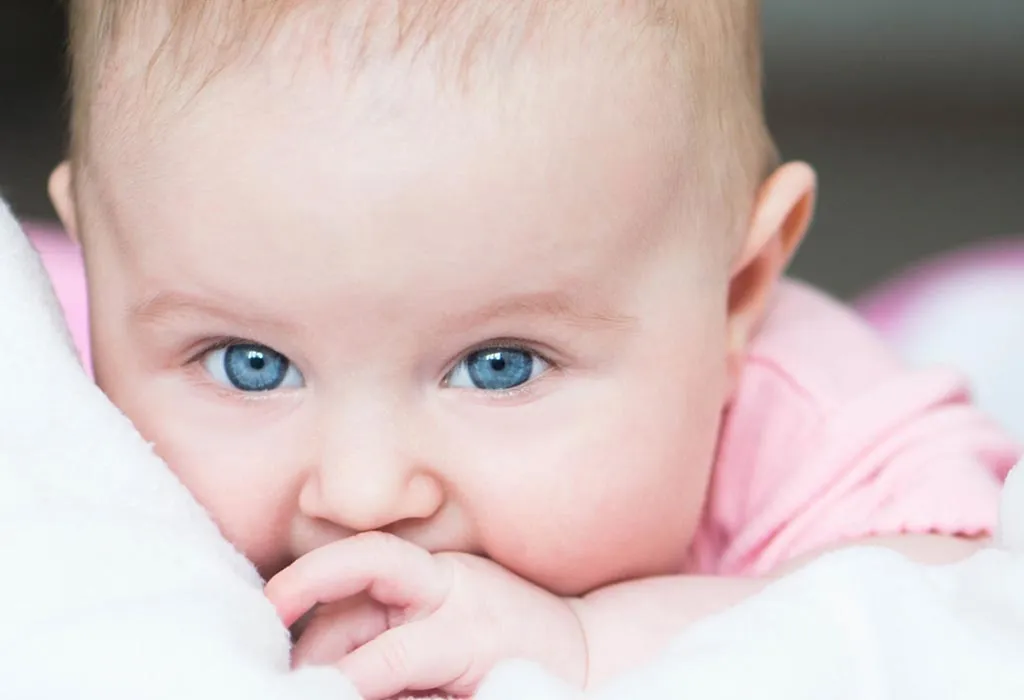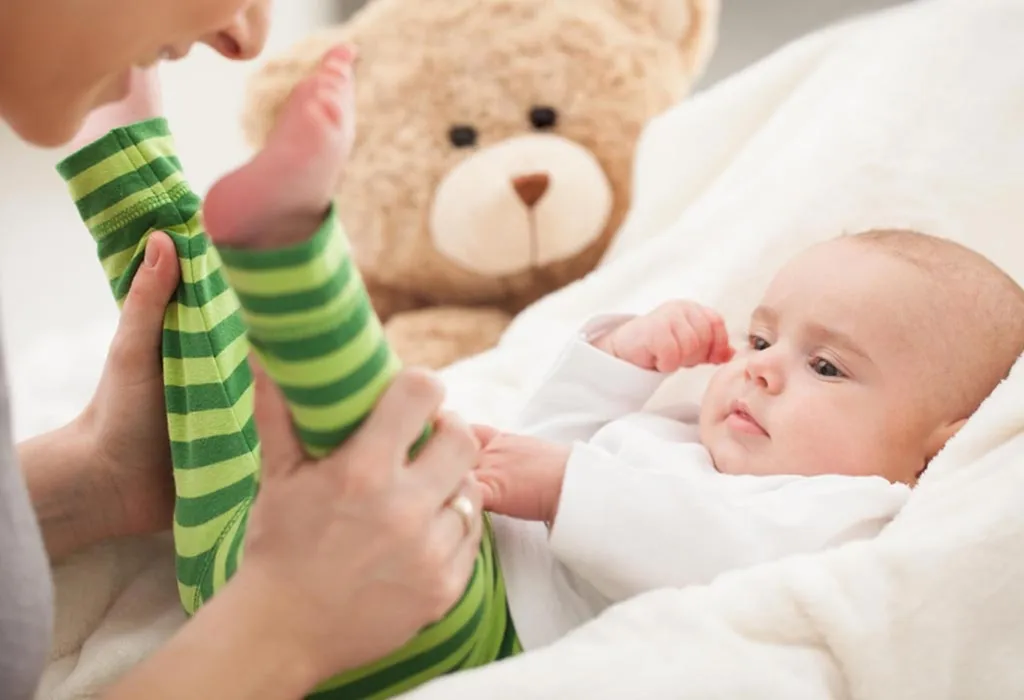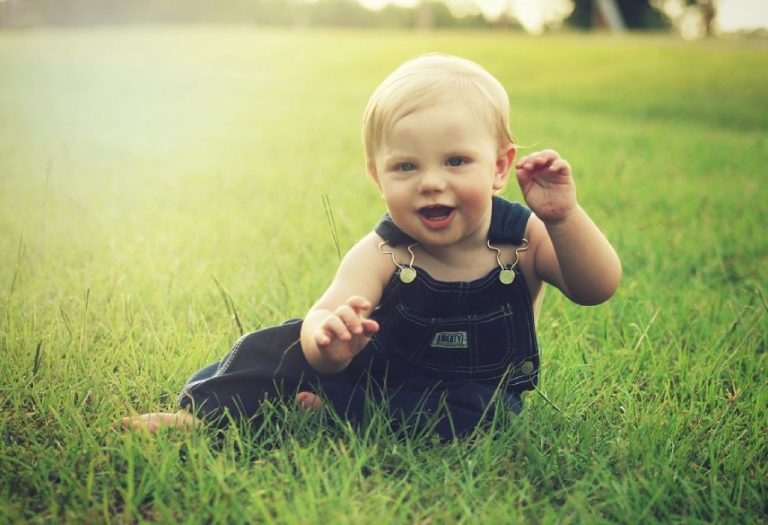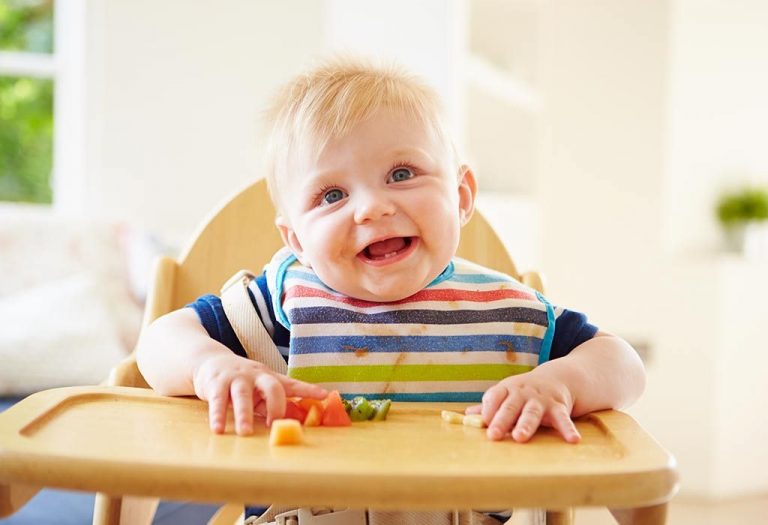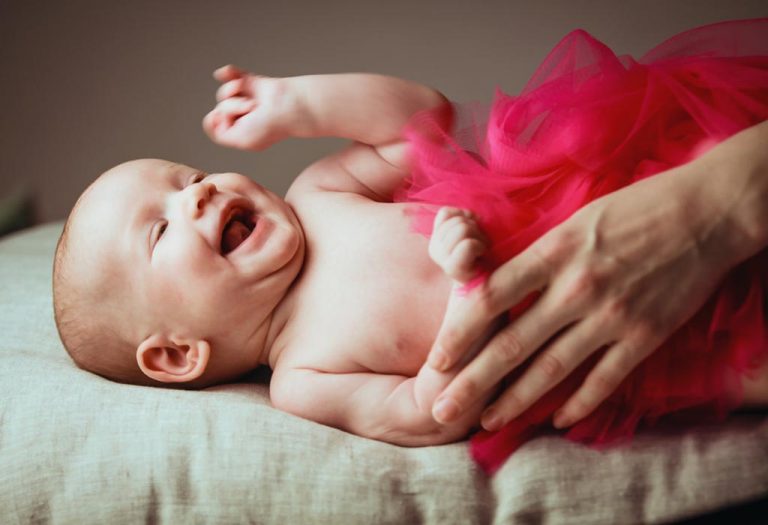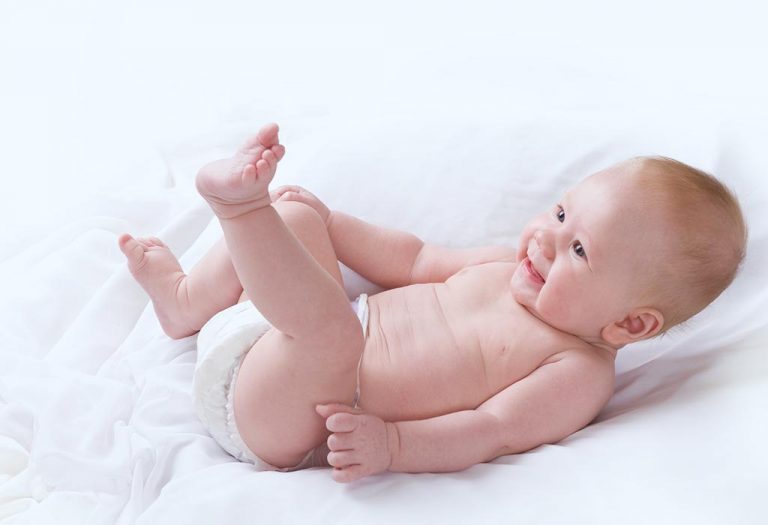Your 3 Months Old Baby Growth and Development

Isn’t it unbelievable that your little patootie is already three months old? Single-handedly, she has managed to transform your life and has given it a new meaning altogether. Not only is she growing rapidly, but she springs so many surprises every day. 3-month-old milestones allow babies to graduate from newborns to infants. From tracking objects with her eyes to pushing up on her arms when lying on her stomach and trying to reach for objects, your 3-month-old baby’s growth and development are super exciting and engaging. To understand infant development at 3 months better, read on to find out the various parameters mentioned in this article.
3 Month Old Baby Weight and Length
At three months in her new world, your baby has now grown in length and seems larger, too. Their weight, too, has doubled in three months since birth. Shopping for a larger size of baby clothes will become a priority for most mothers, as your visibly round baby won’t seem to fit in newborn clothes anymore. Indian summers, however, can spare you these expenses as a nappy and a soft singlet can be the perfect attire for your baby. Remember that your baby will grow in weight and length, so make sure you use all those clothes you’ve bought instead of saving them for later.
To help you, here are the weight and length estimates for three-month-old baby boys and baby girls:
| Gender | Average Weight for 3-month-old | Average Length for 3-month-old |
| Boy | 14 pounds 2 ounces | 24 inches |
| Girl | 12 pounds 13 ounces | 23 1/2 inches |
Baby Development
Below are some of the weekly developments your baby goes through:
12 Week Old Baby Development
Your 12-week-old will be sleeping longer at a stretch, up to 4 hours without waking up for feeding (1). The baby starts to notice the difference between day and night and sleeps more during the night while waking up once or twice for feeding. Her sleep pattern is changing slowly but surely. Her eyes will be well-coordinated, and she will fix her gaze on toys and the mother’s face, and her depth perception will be better, too. She will enjoy watching her own hands. If your baby seems like she’s squinting, take your doctor’s advice since it could mean vision issues later.
13 Week Old Baby Development
Your baby’s vision is steadily improving, as does her perception of colour. She is able to focus on objects and faces and also able to follow a moving object with her eyes (2). It is also the right time to give your baby a whiff of fresh flowers or a sweet-smelling fruit. She will turn her head towards music and other interesting sounds. Her motor skills and hand-eye coordination will start to get better when she enters week 13. Shrieking sounds will be common at this stage, and you will often find your little one cooing to herself.
14 Week Old Baby Development
Your baby’s world is now at its fullest and most colourful glory, as she can now differentiate between hues and bold colours (3). Her world is suddenly a new one with fresh and vibrant colours being infused into it. She will begin to respond more enthusiastically to your presence in the room and give a more pronounced reaction to your voice (4).
15 Week Old Baby Development
As the neck muscles grow stronger, the baby can hold her head upright and look above when sleeping on her belly (5). Help your baby to strengthen these muscles by propping up pillows behind her or by adopting a slightly upright position in the stroller. Expect a few cries during the night when she attempts to roll over and gets stuck doing so. It is best to put your baby on her tummy as early as possible so that she gets used to it.
Baby Health
Adults can always communicate with the doctor when they are afflicted with a disease. With a 3-month-old baby, this is obviously difficult. However, they have another way of communicating with people: crying. Always be on the lookout for unwarranted crying. If this is followed by weakness and reduced mobility, take the baby to a paediatrician immediately.
Baby Milestones – 3 Months
Your baby’s three-month-old milestones and development will revolve around three areas, viz. physical, cognitive, and emotional. These milestones will signify the baby’s growth and can be measured accordingly (6).
- Improvement in gross motor skills: The baby will be able to lift her head up to a 45-degree angle, and the growing strength in the baby’s neck muscles allows her to lift her head when she is on her tummy.
- Response to sounds: Your baby will start to turn her head towards a source of sound, which indicates that her audio senses are developing. Familiar sounds, like your voice or when the phone rings, will elicit such responses.
- Increase in vocal communication: During this phase, the baby might squeal in pleasure and make noises or babble in response to what she hears. Although the babbling and actions will not resemble the real thing, this will be an important milestone for your baby.
Behaviour
Your bundle of joy will surely live up to this moniker at 3 months and announce her presence in the house with squeals and high-pitched sounds. Her sounds of delight will keep the entire household on its toes as she will try out newer (and not necessarily pleasant) vocal skills (7). Your baby may be slightly scared of her own voice, so ensure your feedback is a positive one that says those sounds are okay.
3 Months Old Baby Activities
If you want to know what activities to do when your baby is growing up, check the following ideas for a great time with your child:
- Provide toys: Put your baby on her back or tummy and dangle toys over her head so that she can enjoy the colours and sounds. Place toys of different shapes in her hand so that she can learn to grip objects. Provide toys of colours that she can enjoy variety.
- Practice head support: Put your baby on your lap in such a manner that she faces you while ensuring enough support for her back and neck region. Attract her attention by making noises, giggling, and calling out to her so she looks up to you.
- Tummy time: Turn your baby onto her stomach and place a few brightly coloured toys or objects in front of her and above her head. You can lie in front of her so that she lifts her head and upper body by using her arms to take a look at you. By doing so, you will help strengthen her neck muscles and upper body, as well as your bond!
- Tracking toys: Put the baby on the floor and roll a ball or a toy car in front of her. This will encourage her to follow the toy and track its movement. Use a rattle to grab her attention if she doesn’t show any interest initially.
- Using the baby’s name: Use your baby’s name as often as possible, as her name will be the first word she will connect to. Use it while singing songs and lullabies or when having a conversation with her. While singing to her, vary your voice and pitch to keep her interested.
3 Months Old Baby Care
Follow the below-mentioned tips to keep your infant healthy and safe during this period:
- Breastfeeding is essential: Breast milk is the most important part of a baby’s diet, so make sure you continue breastfeeding your three-month-old. This will also help you create a feeding schedule. Avoid any kind of solid food, cow’s milk, or juice, as breast milk is the healthiest food for your little one.
- Sleep is important: Your baby might be sleeping for 4 to 5 hours at a stretch. Do not rock her if she is going off to sleep on her own. She might get up a couple of times in the night and may need to be fed to get to sleep. However, all babies have varying sleep patterns, and the routine of one baby can be completely different from another due to reasons such as colic.
- Communicate well: At three months, your baby’s responsiveness to sounds and gestures is high, and it will be more expressive, too. Use gestures to make your baby laugh, smile, and talk to her.
- Use safety precautions: You will have to be extra careful regarding your baby’s safety now since her movements and activities have increased.
- Promote development changes: Many important development changes like drooling, chewing and sucking will occur during the third month (1). Use teethers to good effect here since babies like to chomp on things, and it can be an amusement for them. Spend some time outdoors in the park to give her a taste of her surroundings.
3-Month-Old Feeding Schedule
By month three, you and your baby will have managed to create a fairly settled feeding routine between yourselves (8). Your baby’s skills at feeding will have improved dramatically, and your ability, too, will have improved tremendously. As a mother, you will now be able to distinguish between your baby’s hunger cry and the cry that has boredom written all over it. Your baby’s sleep duration will increase, so you will find a bit of relief if you are breastfeeding. If your baby is bottle-fed, expect the sleeping hours to increase slightly earlier.
3-Month-Old Sleeping Schedule
Typically, your 3-month-old will sleep for 14-15 hours in the day, which includes short naps during the day and night-time sleep. Since night feeds have been reduced to a minimum, expect your child to sleep for 4-5 hour stretches (1). This happens because your baby’s nervous system is maturing, which allows her stomach to accommodate a larger quantity of milk or baby food. However, don’t just expect her to sleep throughout the night just yet; you will still need to be available on-call for feeds a couple of times.
Tips for Parents
Parenting is a hands-on learning experience for most, although a bit of support from experienced and well-meaning friends and relatives is useful. Here are a few tips to go through this phase with ease:
- Irrespective of all the advice you may hear, do not start with solids at this stage. Your baby should be at least 6 months old before you do it. Till that time, breast milk is the ideal food for your little one, as she receives all the necessary nourishment through it.
- Create a routine of feeding, sleeping, and playtime with your baby. This ensures that your tiny tot will get used to a schedule and will fall off to sleep at night without much of a fuss. 7 pm to 9 pm will be the ideal time for your baby to sleep, and this will encourage longer sleep durations during the night.
- Get the baby’s check-up done and schedule one for the next month as well.
- Parents are often anxious about the ideal 3-month-old baby’s weight. Though your doctor will be the right person to speak to, if it’s a boy, he should weigh between 6 and 6.5 kg, while a baby girl should weigh between 5.5 and 5.8 kg.
FAQs
1. When should I contact a doctor?
Every child is unique, and so are milestones. If they miss any or some milestone, don’t be alarmed, especially if they are premature. Nonetheless, if your baby has missed any of these marks, contact your paediatrician (9):
- Reaching for objects
- Responding to noises
- Smiling
- Following people or moving objects with their eyes
- Stiff or sloppy muscles
- Hold head or neck steady
2. How do you ensure your 3-month-old baby achieves milestones?
To help your baby achieve 3-month developmental milestones, you can start giving them tummy time and help them build strength for rolling, crawling, and sitting up. You can talk, read, play, smile, or sing with them to build their emotional, language, and social skills. If you have been doing all these, continue doing so.
3. What does a three-month-old baby understand?
Recognising familiar voices, most probably of their caregivers, is one of the most important 3-month infant milestones. A three-month-old child is beginning to smile when they see familiar faces and make cooing sounds as a way of interacting with people. they are learning to grab and release toys and kick their legs.
It is important to understand that every baby will have her own development speed, and milestones may come early or late. Your apprehensions about your baby’s growth are justified but can be easily put to rest. Keep a watch on the developments, and report any abnormal activity to your doctor, as that’s the best way of going forward.
References/Resources:
1. Infant Sleep; Stanford Medicine; https://www.stanfordchildrens.org/en/topic/default?id=infant-sleep-90-P02237
2. Infant Vision Development: What Can Babies See?; American Academy of Pediatrics; https://www.healthychildren.org/English/ages-stages/baby/Pages/Babys-Vision-Development.aspx
3. Infant development: Birth to 3 months; Mayo Clinic; https://www.mayoclinic.org/healthy-lifestyle/infant-and-toddler-health/in-depth/infant-development/art-20048012
4. 1-3 Months Old Baby Development; CHOC; https://choc.org/primary-care/ages-stages/1-to-3-months/
5. Your baby’s growth and development – 3 months old; Pregnancy, Baby and Birth; https://pregnancybirthbaby.org.au/babys-growth-and-development-3-months-old
6. Developmental Milestones: 3 Months; American Academy of Pediatrics; https://www.healthychildren.org/English/ages-stages/baby/Pages/Developmental-Milestones-3-Months.aspx
7. Milestone Moments Booklet 2021; CDC; https://www.cdc.gov/ncbddd/actearly/pdf/parents_pdfs/milestonemomentseng508.pdf
8. Your Baby’s Growth: 3 Months; Nemours KidsHealth; https://kidshealth.org/en/parents/growth-3mos.html
9. Is Your Baby’s Physical Development on Track?; American Academy of Pediatrics; https://www.healthychildren.org/English/ages-stages/baby/Pages/Is-Your-Babys-Physical-Development-on-Track.aspx
Also Read:
2 Months Old Baby Growth
4 Months Old Growth and Development
5 Month Old Baby Growth and Development
Was This Article Helpful?
Parenting is a huge responsibility, for you as a caregiver, but also for us as a parenting content platform. We understand that and take our responsibility of creating credible content seriously. FirstCry Parenting articles are written and published only after extensive research using factually sound references to deliver quality content that is accurate, validated by experts, and completely reliable. To understand how we go about creating content that is credible, read our editorial policy here.







